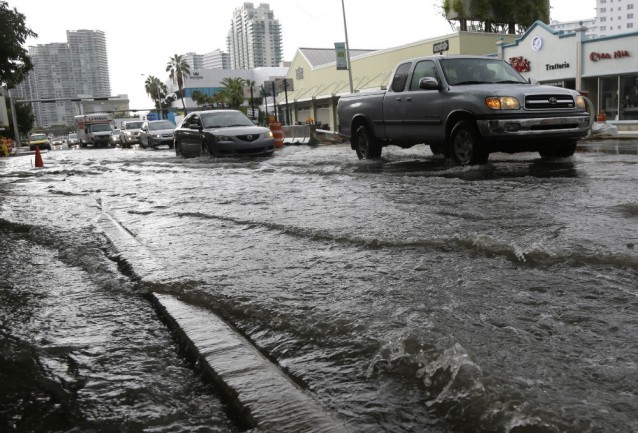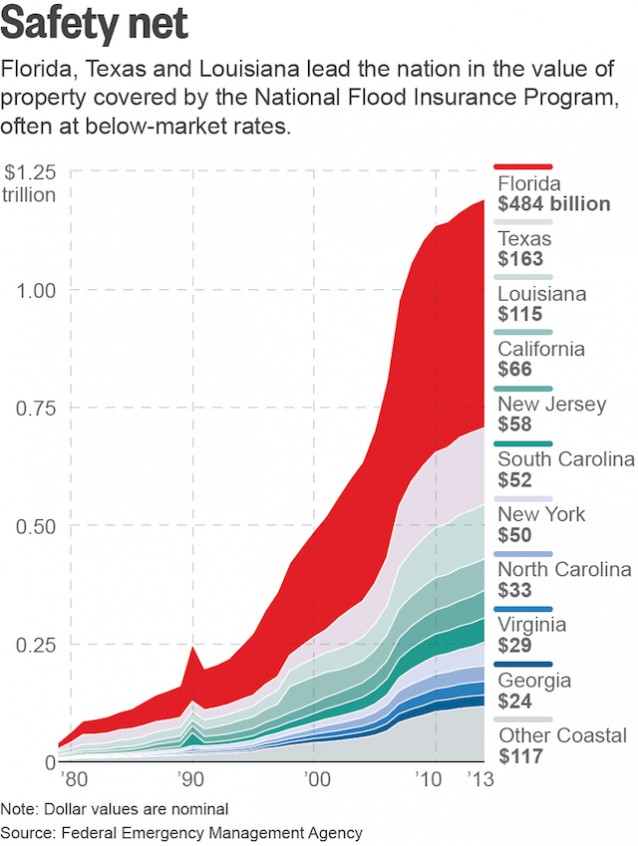
Florida’s climate denial could cause catastrophic recession
Miami streets see heavy flooding from rain in September 2014. Some neighborhoods flood regularly during deluges or extreme high tides.
Governor Rick Scott (R-FL) has made Florida the punchline for countless jokes since we learned in early March he barred state officials from using the term “climate change.” As Jon Stewart joked last week holding a copy of “Roget’s Denial Thesaurus,” Florida is headed toward “statewide jacuzzification,” and “It appears by 2020, Miami will be involved in a surprise pool party.”
But the joke is on all of us: Florida has led the way in all but ignoring the growing twin threats created by human-caused climate change — sea level rise and superstorm surge — thereby creating a trillion-dollar real-estate bubble in coastal property. When the next superstorm like Katrina or Sandy makes its target Florida and bursts that bubble, the state can declare bankruptcy. So too could some insurance companies. But taxpayers — you and I — will get the several hundred billion dollar bailout bill.
And a bailout will be the best-case scenario for all of us. When the coastal property real estate bubble bursts, what measures do we have in place to stop another catastrophic recession like the most recent one, which was also driven by a real estate bubble bursting?
Let’s do the math. There is now at least $1.4 trillion in property within 660 feet of the U.S. coast, a detailed analysis of the data by Reuters found. Worse, “incomplete data for some areas means the actual total is probably much higher.”
While Florida is denying the very existence of climate change, astrophysicist Neil deGrasse Tyson is here to remind us that, “The good thing about science is that it’s true whether or not you believe in it.” And what science told us in the last 12 months about likely sea level rise has been shocking. It’s the kind of news that should have stopped coastal development cold.
Last May, we learned that the West Antarctic Ice Sheet (WAIS) appears close to, if not past, the point of irreversible collapse. Relatedly, “Greenland’s icy reaches are far more vulnerable to warm ocean waters from climate change than had been thought.”
We also learned in August that Greenland and the WAIS more than doubled their rate of ice loss in the last five years.
Already this year, we learned two more stunners. First, a large glacier in the East Antarctic Ice Sheet turns out to be as unstable and as vulnerable to melting from underneath as WAIS is. This alone could “could lead to an extreme thaw increases sea levels by about 11.5 feet (3.5 meters) worldwide if the glacier vanishes.”
Second, two new studies find that global warming is weakening a crucial ocean circulation pathway in the North Atlantic, the Gulf Stream system, to a level “apparently unique in the last thousand years.” And if that circulation continues to weaken, it would also add another few feet of sea level rise to the East Coast. Indeed, this weakening is maybe one reason why large parts of the East Coast are already experiencing much faster sea level rise than the rest of the world.
A January study found that global sea level rise since 1990 has been speeding up even faster than we knew. “The sea-level acceleration over the past century has been greater than had been estimated by others,” explained lead writer Eric Morrow. “It’s a larger problem than we initially thought.”
The recent findings have led top climatologists to conclude we are headed toward what used to be the high end of projected global sea level rise this century: four to six feet or more. A 2013 NOAA studyfound that, under such sea level rise, the areas that received the very worst storm surges from Superstorm Sandy — such as devastated places like Sandy Hook and The Battery — will be inundated by such storm surges every year or two. In fact, in that scenario, the New Jersey shore from Atlantic City south would see Sandy level storm surges almost every year by mid-century
Worse, as discussed above, the East Coast of the United States is very likely headed toward considerably higher sea level rise over the next century than the planet as a whole. If we don’t take very aggressive action to slash carbon pollution, we could be facing a rise upwards of 10 feet. And considerably more than that after 2100 — sea level rise exceeding a foot per decade.
And so we are in a major coastal real estate bubble.
How big is the bubble, and who will pay when it bursts? The excellent Reuters series, “The crisis of rising sea levels: Water’s Edge,” has a sobering chart:
It’s a trillion-dollar bubble. And it looks like American taxpayers are on the hook for much of it.
Florida is ground-zero for this bubble for several reasons. First, as the chart shows, Florida’s $484 billion leads the country in “the value of property covered by the National Flood Insurance Program, often at below market rates.” Indeed, its covered property is three times as much as the next state, Texas.
Second, Florida’s topology makes some of its urban coastal areas especially vulnerable to warming-driven sea level rise and storm surge. Tampa Bay has unique geography that puts it atop Climate Central’s list of U.S. cities most vulnerable to a direct hit from a major hurricane. And Miami is second on the list!
The Miami area is so flat that even with a mere three feet of sea-level rise, “more than a third of southern Florida will vanish; at six feet, more than half will be gone.”
Third, Miami-Dade County by itself has some $94 billion worth of property along coastal waters — and the city can’t protect itself the way many coastal cities can. “Conventional sea walls and barriers are not effective here,” explained Robert Daoust, who works at a Dutch firm specializing in designing responses to rising sea levels. Why? As Jeff Goodell noted in Rolling Stone:
South Florida sits above a vast and porous limestone plateau. “Imagine Swiss cheese, and you’ll have a pretty good idea what the rock under southern Florida looks like,” says Glenn Landers, a senior engineer at the U.S. Army Corps of Engineers. This means water moves around easily – it seeps into yards at high tide, bubbles up on golf courses, flows through underground caverns, corrodes building foundations from below.
For all these reasons, Harold Wanless, chair of University of Miami’s geological sciences department, told National Geographic in 2013, “I cannot envision southeastern Florida having many people at the end of this century.” In 2014, he said, “Miami, as we know it today, is doomed. It’s not a question of if. It’s a question of when.”
Under these dire circumstances, a rational statewide response might be to stop all new coastal development, have insurance priced according to risk, and start doing some intense planning. Instead we have Rick Scott’s complete denial, and sharp cuts in the budget for the South Florida Water Management District. Chuck Watson, a disaster impact analyst with a great deal of Florida experience, has warned, “There is no serious thinking, no serious planning, about any of this going on at the state level.
“The view is, ‘Well, if it gets real bad, the federal government will bail us out,’ he said. “It is beyond denial; it is flat-out delusional.”
The state level denial, while easy to milk for laughs, is thus epically tragic — and not just for Floridians, but for all of us.
Significantly, the planning going on at the local level, while better informed, is still relatively blind to what’s coming and what the response needs to be. That is clear from a very recent article by WLRN, South Florida Public Radio, “An Idea To Mitigate Rising Seas In Miami Beach: Lift The Entire City.”
KLRN interviewed public works director for the City of Miami Beach, Eric Carpenter, who asserted “The only tried and true solution to combating rising sea levels is to raise with it.” Seriously.
KLRN asked Carpenter about the sea-level rise projections Miami uses:
“All we can really count on are the projections that are made by the people that do this for a living. The Army Corps of Engineers are a great source of information. They’re projecting anywhere between seven and 24 inches of sea-level rise over the next 50 to 75 years. … We’re kind of picking numbers that are in the mid to upper portion of that range to be on the conservative side.”
Two feet by 2090 is not conservative. As KLRN points out, South Florida task forces “projected seas to rise anywhere from two to six feet by the end of the century” — last decade. The new findings discussed above make clear that the worst-case scenarios for sea level rise from the last decade have now become simply the “business-as-usual” scenario. Generally people prepare for the plausible worst-case — buying catastrophic health insurance, for instance — since the consequences of underestimating what’s to come can be so ruinous.
Miami should be planning for sea level rise of 6 to 10 feet by century’s end and a foot per decade rise after that. And it’s hard to see how “raising the city” is the optimal response. Is the plan to turn Miami into Venice? Will the valuable parts of Miami simply keep elevating themselves until the place becomes an island disconnected from the rest of South Florida, which will be underwater?
And what about storm surge? What happens when the new island fortress of “Miami Beachless” gets devastated by a major hurricane post-2050, with a storm surge of 10 to 20 feet?
There is a trillion-dollar bill on its way, with no one stepping up to pay it.
(From: ThinkProgress)


